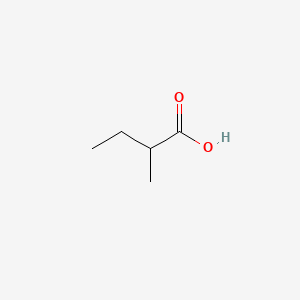| MeSH term | MeSH ID | Detail |
|---|---|---|
| Adenocarcinoma | D000230 | 166 associated lipids |
2-Methylbutanoic acid
2-Methylbutanoic acid is a lipid of Fatty Acyls (FA) class. The involved functions are known as Binding (Molecular Function), Oxidation, isoleucine catabolic process, Anabolism and physiological aspects. 2-methylbutanoic acid often locates in Membrane, soluble and host. The associated genes with 2-Methylbutanoic acid are Homologous Gene, Genome, NKS1 gene, HM13 gene and ACSM1 gene. The related lipids are Fatty Acids, Butyric Acids, branched chain fatty acid, Propionate and 2-methylvalerate.
Cross Reference
Introduction
To understand associated biological information of 2-Methylbutanoic acid, we collected biological information of abnormalities, associated pathways, cellular/molecular locations, biological functions, related genes/proteins, lipids and common seen animal/experimental models with organized paragraphs from literatures.
What diseases are associated with 2-Methylbutanoic acid?
There are no associated biomedical information in the current reference collection.
Possible diseases from mapped MeSH terms on references
We collected disease MeSH terms mapped to the references associated with 2-Methylbutanoic acid
PubChem Associated disorders and diseases
What pathways are associated with 2-Methylbutanoic acid
There are no associated biomedical information in the current reference collection.
PubChem Biomolecular Interactions and Pathways
Link to PubChem Biomolecular Interactions and PathwaysWhat cellular locations are associated with 2-Methylbutanoic acid?
Visualization in cellular structure
Associated locations are in red color. Not associated locations are in black.
Related references are published most in these journals:
| Location | Cross reference | Weighted score | Related literatures |
|---|
What functions are associated with 2-Methylbutanoic acid?
Related references are published most in these journals:
| Function | Cross reference | Weighted score | Related literatures |
|---|
What lipids are associated with 2-Methylbutanoic acid?
Related references are published most in these journals:
| Lipid concept | Cross reference | Weighted score | Related literatures |
|---|
What genes are associated with 2-Methylbutanoic acid?
Related references are published most in these journals:
| Gene | Cross reference | Weighted score | Related literatures |
|---|
What common seen animal models are associated with 2-Methylbutanoic acid?
There are no associated biomedical information in the current reference collection.
NCBI Entrez Crosslinks
All references with 2-Methylbutanoic acid
Download all related citations| Authors | Title | Published | Journal | PubMed Link |
|---|---|---|---|---|
| Banskota AH et al. | Three new C-14 oxygenated taxanes from the wood of Taxus yunnanensis. | 2002 | J. Nat. Prod. | pmid:12444707 |
| Okamoto S et al. | New decalin derivatives, eujavanoic acids A and B, from Eupenicillium javanicum. | 2004 | J. Nat. Prod. | pmid:15387665 |
| Reineri F et al. | Effect of low and zero magnetic field on the hyperpolarization lifetime in parahydrogenated perdeuterated molecules. | 2009 | J. Magn. Reson. | pmid:19535274 |
| Araújo SM et al. | Biotechnological process for obtaining new fermented products from cashew apple fruit by Saccharomyces cerevisiae strains. | 2011 | J. Ind. Microbiol. Biotechnol. | pmid:21069555 |
| Monticello DJ et al. | Isoleucine synthesis by Clostridium sporogenes from propionate or alpha-methylbutyrate. | 1984 | J. Gen. Microbiol. | pmid:6726176 |
| Lee GH et al. | Aroma-active components of Lycii fructus (kukija). | 2008 | J. Food Sci. | pmid:19241541 |
| Antón MJ et al. | Aromatic profile of ciders by chemical quantitative, gas chromatography-olfactometry, and sensory analysis. | 2014 | J. Food Sci. | pmid:24313985 |
| Aiello RJ and Armentano LE | Effects of volatile fatty acids on propionate metabolism and gluconeogenesis in caprine hepatocytes. | 1987 | J. Dairy Sci. | pmid:3448105 |
| Peirce-Sandner SB et al. | Supplementation of dairy cow diets with ammonium salts of volatile fatty acids. | 1985 | J. Dairy Sci. | pmid:4078120 |
| Johnson BA and Leon M | Odorant molecular length: one aspect of the olfactory code. | 2000 | J. Comp. Neurol. | pmid:10982472 |
